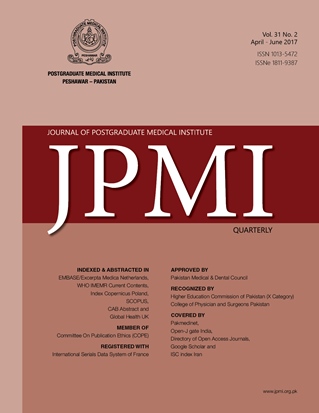CAUSATIVE FACTORS AND CLINICAL OUTCOME IN STEVEN JOHNSON SYNDROME AND TOXIC EPIDERMAL NECROLYSIS
Main Article Content
Abstract
Objective: To identify the main factors causing Steven Johnson syndrome (SJS)
and toxic epidermal necrolysis (TEN) and their clinical outcome in the patients
in our local setup.
Methodology: This case series was conducted at Lady Reading Hospital, Peshawar.
A total of 54 consecutive patients who presented with Steven Johnson
syndrome and toxic epidermal necrolysis over a two year period (2013-2015)
were included in the study. Relevant information including bio-data, causative
agents, duration of hospital stay and outcome in terms of improvement or mortality
was collected. Analysis was done using SPSS version 20.
Results: The mean age of patients presenting with SJS/TEN was 25.9±17.4
years with a minimum age of 1 year and a maximum age of 65 years. Majority
of patients were between 18-45 years of age. The causes identified for triggering
SJS/TEN were anticonvulsants (38.9%), followed in equal frequency by
antibiotics and NSAIDS (27.8%) while 5.5% of cases were secondary to herpes
virus infection. Patients had a variable course with 83.3% of patients improving
with no sequel on follow-up and 16.7% succumbing to the disease.
Conclusion: Anticonvulsants, antibiotics and NSAIDS were the most frequently
responsible drugs for development of SJS & TEN. The Observed mortality rate
was 16.7%.
and toxic epidermal necrolysis (TEN) and their clinical outcome in the patients
in our local setup.
Methodology: This case series was conducted at Lady Reading Hospital, Peshawar.
A total of 54 consecutive patients who presented with Steven Johnson
syndrome and toxic epidermal necrolysis over a two year period (2013-2015)
were included in the study. Relevant information including bio-data, causative
agents, duration of hospital stay and outcome in terms of improvement or mortality
was collected. Analysis was done using SPSS version 20.
Results: The mean age of patients presenting with SJS/TEN was 25.9±17.4
years with a minimum age of 1 year and a maximum age of 65 years. Majority
of patients were between 18-45 years of age. The causes identified for triggering
SJS/TEN were anticonvulsants (38.9%), followed in equal frequency by
antibiotics and NSAIDS (27.8%) while 5.5% of cases were secondary to herpes
virus infection. Patients had a variable course with 83.3% of patients improving
with no sequel on follow-up and 16.7% succumbing to the disease.
Conclusion: Anticonvulsants, antibiotics and NSAIDS were the most frequently
responsible drugs for development of SJS & TEN. The Observed mortality rate
was 16.7%.
Article Details
How to Cite
1.
Paracha MM, Noor SM, Khan HA. CAUSATIVE FACTORS AND CLINICAL OUTCOME IN STEVEN JOHNSON SYNDROME AND TOXIC EPIDERMAL NECROLYSIS. J Postgrad Med Inst [Internet]. 2017 May 12 [cited 2025 Dec. 13];31(2). Available from: https://jpmi.org.pk/index.php/jpmi/article/view/2072
Issue
Section
Original Article
Work published in JPMI is licensed under a
Creative Commons Attribution-NonCommercial 2.0 Generic License.
Authors are permitted and encouraged to post their work online (e.g., in institutional repositories or on their website) prior to and during the submission process, as it can lead to productive exchanges, as well as earlier and greater citation of published work.


